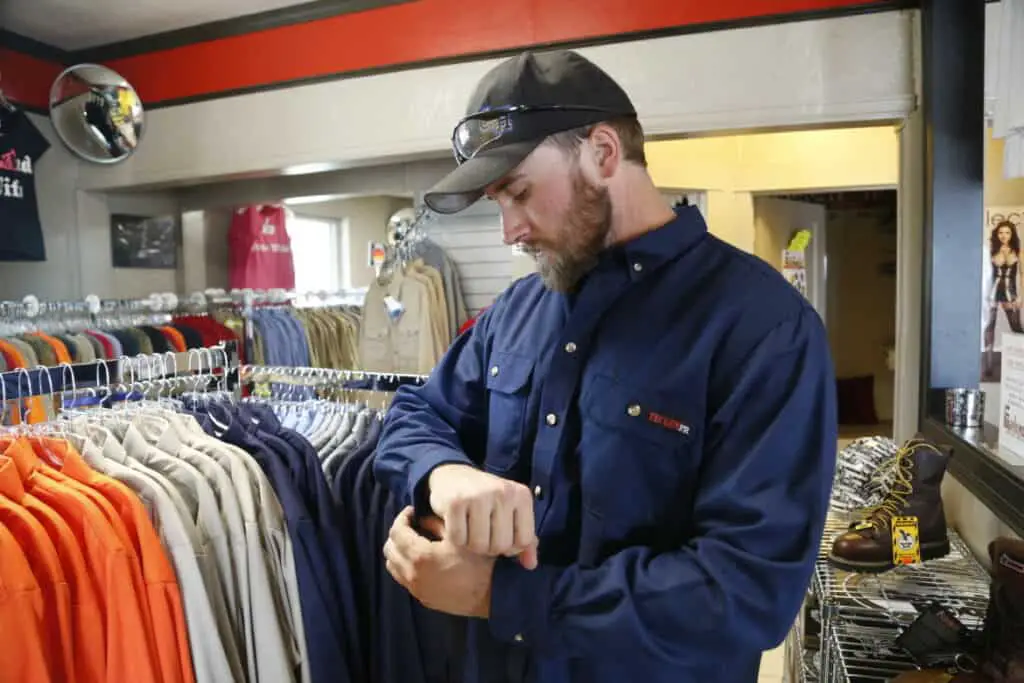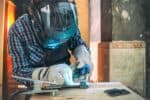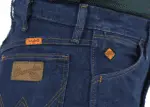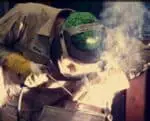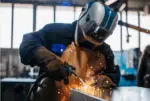Welding brings along the unsettling feeling of being surrounded by intense heat. Sparks flailing all over, flames, and debris from molten metal are just as much safety concerns as UV rays, infrared rays, and fumes are.
The clothes that welders wear are their first layers of protection against hazards that can burn them while working. Most welders prefer wearing 100% cotton shirts for welding.
Cotton shirts (even twill cotton and denim) for welding have slight bits of differences than your regular cotton shirt. Did you know that it’s implicitly recommended that welders should wear flame-resistant (FR) shirts only?
If you’re a welder too and you want to understand everything about FR shirts and how they can protect you, this detailed post will be a delightful read.
By the end, you’ll be able to figure out what are the best choices of welding shirts you have, the different things you should keep in mind while buying a welding shirt, and much more. Dive in for all the answers!
FR welding shirt guidelines: Things you must know!
FR is a very important word in welding. It stands for flame resistance. Before we take you any deeper, we’d first like to clarify that there’s no piece of clothing that is entirely fireproof.
Every fabric has an ignition point. The ones that are flame-resistant (RF) are the ones that will defend you the best against high temperatures. Meaning, their ignition point is very high. They self-extinguish because below their ignition point, they do not catch fire.
When you’re wearing an FR welding shirt, you will have time to walk away from the fire safely before anything major happens. That’s how these shirts will protect you from burn injuries.
That said, let’s now walk you through the FR specifications as suggested by ASTM and tested by OSHA.
1.) 100% cotton can be labelled as FR only when it has a certain weight. Lightweight cotton shirts (no matter 100% cotton) will not give the fabric enough time to self-extinguish. That contradicts the entire context of flame-resistant clothing.
2.) The use of synthetic fibers like rayon and polyester in addition to cotton is not encouraged. Such synthetic materials are susceptible to fire. They ignite easily. So, a shirt cannot be approved as FR if it’s cotton blended with inflammable fabrics.
3.) FR shirts have ratings from 1 to 4, 1 offering the lowest protection and 4 offering the highest. The FR-rated shirt that you should buy depends on the extent of heat and danger involved. The higher the temperature and voltage you work at, the higher the FR rating should be.
What kind of shirts do welders wear – What is the best fabric for welding shirts?
As you know by now, flame-resistant shirts that are tested and approved by the OSHA are the best options for welders.
These shirts can withstand very high temperatures. Even if a spark flows into your FR shirt, a fire won’t break as long as the ignition point of the fabric isn’t reached.
100% cotton, twill cotton, and denim of certain weight are the three best fabrics for welding shirts. However, there are some other fabrics too that offer a more than decent degree of flame resistance.
Here’s a list apart 100% cotton and denim:
-
-
- 88% cotton + 12% nylon.
- Cotton and leather blend fabric.
- Tecasafe® PLUS fabric.
- Nomex® fabric.
- CXP Nomex®
- Excel-FR® and Excel-FR® ComforTouch® fabrics.
- Indura® fabric.
- UltraSoft™ fabric.
-
3 Things to Consider When Buying a Welding Shirt
#1. FR treated shirts and FR inherent shirts are different
Although both the types are FR shirts rated by OSHA, there’s a great deal of difference between the two.
An FR inherent welding shirt can also be called an FR intrinsic shirt. When you read this term, it means that the fabric of that shirt (or atleast one fabric, if the shirt is a blend of more than one fabric) is fire-resistant naturally.
• The degree of protection from heat and flames offered by FR inherent shirts is very high.
• These shirts are more expensive.
• Their life is longer. It means they do not lose their fire resistance ability soon.
• Since FR inherent shirts are naturally resistant to flames, they don’t have to be too bulky. Hence, they are lightweight and easy to wear throughout the day.
An FR treated welding shirt means that the fabric isn’t fire-resistant to a great degree naturally. It is a clear declaration that the fabric is chemically treated to make it extremely resistant to fire.
• FR treated welding shirts offer the best protection from splashes from molten metal.
• They’re a lot more affordable.
• Since they have to be chemically prepared to be resistant to high temperatures and oil, they get bulkier than FR inherent shirts.
#2. The declaration Matters
It doesn’t matter whether manufacturers say that their shirts are FR category 1 or 2 or 3 or 4, if they don’t clearly declare that their garments are in compliance with ASTM or NFPA 60e standards, it’s a red flag. It could very well be that the shirt isn’t really approved as self extinguishable.
It’s even better if the word FR is inscribed on the surface of the shirt directly. So, be fussy! After all, it’s better to be safe than sorry.
#3. Buy the Right Size
Remember, a welding shirt should offer comfort. There’s no point in buying a shirt that’s too tight or too loose even if it’s an FR 4 shirt.
You ask us why? Well, a welding shirt that’s too tight will restrict your movement, and when too loose, it will keep dropping from your shoulders. In both cases, your work efficiency will reduce.
FR Treated Shirts or FR Inherent Shirts: Which of the two is Better?
Well, it entirely depends on the purpose you’re buying the shirt for. Let’s give you a tour of certain key elements that’ll help you decide which of the two is the better option for you. Have a look!
1.) If splashes from molten metal are the leading threats, buy FR treated welding shirt only. An FR inherent shirt won’t be able to offer very good protection in such a case.
2.) If you aren’t used to the feel of added weight, buy FR Inherent shirts since they’re a lot less bulky than the FR treated ones.
3.) If your budget is limited, FR treated shirts will be better because FR inherent ones are on the expensive side.
That said, here’s one fun fact that you need to know: both these FR rated welding shirts (treated and inherent) are equally stunning in offering protection from sparks, flames, and heat. They’re equally good when Arc welding.
Needless to say, what’s better for somebody else might not be the best option for you. So, keep the purpose of purchase in mind.
3 Things to Not Compromise With When Buying an FR Rated Welding Shirt
You found an original OSHA-approved FR shirt, all right! But, buying it comes with a lot of responsibility. Here are the 3 things you need to respect so that you don’t regret your purchase:
1.) Your budget – what’s the point in going overboard when there are many fabrics to choose from? So, respect your budget, always.
2.) The color of the shirt – It might sound weird, but it’s important. Don’t buy dull pale colors if you work in dirty conditions. You’ll have to wash the shirt again and again. And it will only reduce the life of the shirt.
3.) The washing technique – If it says that the shirt should only be hand washed, don’t toss it in the machine or the dryer.
It will break the fabrics sooner than they should, which means, your shirt will tear quickly. Similarly, abide by the right water temperature to wash the shirt as mentioned by the manufacturers.
Top 3 FR Shirts for Welding You Should Buy for Protection From Burns
1.) Wrangler Riggs Flame Resistant Tall Plaid Welding Shirt
- Made with a comfortable, relaxed fit through the torso and arms, this long sleeve work shirt is a workwear staple.
- FLAME RESISTANT
- Made with 100 percent FR cotton and finished with safety orange outside ID for enhanced visibility
- NFPA 2112; HRC 2; ATPV 8.5 Calories/cm2; Compliant with OSHA 29 CFR 1910.269, NFPA 70E and ASTM 1506 02ae1.
Prices pulled from the Amazon Product Advertising API on:
Product prices and availability are accurate as of the date/time indicated and are subject to change. Any price and availability information displayed on [relevant Amazon Site(s), as applicable] at the time of purchase will apply to the purchase of this product.
Nothing beats the awesomess of this FR treated 100% cotton shirt for welding. It’s approved by NFPA 2112, HRC 2, ATPV, NFPA 70E, OSHA 29, and ASTM 1506 02ae1.
You can imagine for yourself how worthy this welding shirt must be to approved by so many organisations all across the world.
Some of the most noteworthy features that have earned this welding shirt by Wrangler Riggs the first spot in our list of top 3 welding shirts are as follows.
1.) It’s made of 100% cotton fabric that’s breathable and soft, and has moisture-wicking properties too.
2.) It has a UPF protection. It means that this welding shirt also blocks harmful sunrays. So, it’s perfect when you’re welding outdoors.
3.) It’s water-resistant too.
Cons: Probably, the only con that you might face is the price of this shirt. However, with the properties that it has, it’s absolutely worth every penny spent.
Check Price and Reviews on Amazon2.) Carhartt Men’s Flame Resistant Lightweight Welding Twill Shirt
- Carhartt Company Gear Collection
- 6-ounce FR twill: 88% cotton/12% high-tenacity nylon
- Work-Dry® material wicks away moisture for comfort
- Anti-odor fabric treatment
Prices pulled from the Amazon Product Advertising API on:
Product prices and availability are accurate as of the date/time indicated and are subject to change. Any price and availability information displayed on [relevant Amazon Site(s), as applicable] at the time of purchase will apply to the purchase of this product.
It’s one of the best FR treated welding shirts out there in the market. It’s in full compliance with the NFPA 60e standards. It’s made of 88% cotton and 12% nylon.
Some of the most noteworthy features that have earned this welding shirt a place in our list of most prestigious top 3 welding shirts are as follows.
1.) It has stunning moisture-wicking properties. Hence, it won’t stick to your skin and won’t make you hot either.
2.) It’s a very soft, non-allergenic, and odor-free welding shirt.
3.) It’s very comfortable and features adjustable cuffs.
Cons: Some customers mention that this shirt runs longer than expected. So, read the size chart carefully before buying the shirt.
Check Price and Reviews on Amazon3.) Wrangler Riggs Workwear Flame Resistant Welding Shirt for Women
- WESTERN STYLING
- Arc Thermal Protective Value (ATPV) rating of 9.5 CAL/CM2.
- Finished with contrast stitching from Nomex (FR) thread
- Durable enough to stand up to the daily wear and tear of tough jobs.
Prices pulled from the Amazon Product Advertising API on:
Product prices and availability are accurate as of the date/time indicated and are subject to change. Any price and availability information displayed on [relevant Amazon Site(s), as applicable] at the time of purchase will apply to the purchase of this product.
This welding shirt is made of 88% cotton and 12% nylon that makes it very soft and non-allergenic. With an ATPV rating of a whopping 9.5 CAL, the self-extinguish feature reaches a new high.
If you work at very hot temperatures, then this welding shirt will protect you from some serious burn injuries.
Some of the better features that make this welding shirt a perfect choice for badass ladies are as follows.
1.) It is a very comfortable welding shirt with a comfortable fitting. Hence, it won’t restrict your movement while welding at all.
2.) This welding shirt is absolutely true to its size.
Cons: If you’re not used to the fact that FR treated welding shirts are slightly on the bulker side, then you might find this shirt a little heavy.
Check Price and Reviews on AmazonHowever, that’s a necessary property and the only one that makes this welding shirt highly resistant to flames and splatter from molten metal.
If protection matters to you as much as it should, you must give this shirt a little bit of time. Once you get a hang of its feel, it will be an absolute delight to wear to work every single day.
FAQs
Is 100% cotton good for welding?
Yes, very much. You might be surprised to know that even 100% cotton falls under the category of FR treated welding shirt fabric most of the times, but it’s still the best option amongst all the other fabrics suitable for welding.
Is cotton blend good for welding?
Usually, no. However, a blend of 88% cotton and 12% nylon is a pretty good option; probably, one of the safest blends for welding garments.
Can you weld in a cotton shirt alone?
Absolutely not. You need to wear FR rated gloves, FR rated boots, FR rated helmets, and FR rated googles. Not wearing them will be a big mistake.
Are FR shirts good for welding?
Yes. FR shirts approved by OSHA are the only options that will self extinguish and protect you from serious burn injuries. Wearing shirts that are not flame-resistant is a very bad practice.
See also: Why Do Welders Starch Their Shirts?
Concluding Thoughts:
100% cotton and denim are the two best fabrics for welding shirts. These welding shirts are chemically treated to make them highly resistant against catching a fire.
100% cotton shirts are the best welding shirts not only because they withstand very high temperatures, but also because they offer protection from splashes from molten metal, are affordable, have a very high ignition point, and are available in solid colors.
So, on a parting note, we sincerely hope that you’ve understood you still have many options besides 100% cotton and the many ways that’ll help you in choosing what’s best for you.

